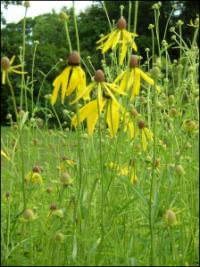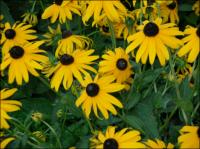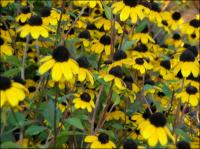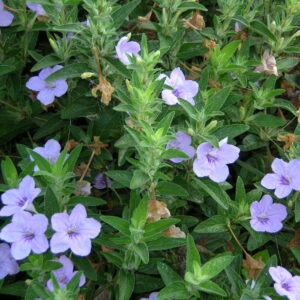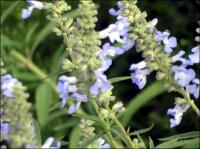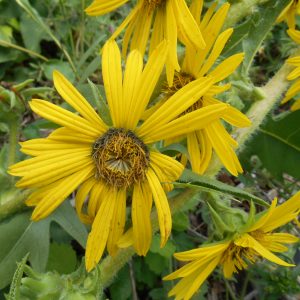Prairie Plants
Showing 65–72 of 81 results
-
Ratibida pinnata Prairie coneflower Z 3-8
Skirt of drooping, sunny, thin petals surround erect brown cone on this fragrant flower, smelling of anise, June-August.
Skirt of drooping, sunny, thin petals surround erect brown cone on this fragrant flower, smelling of anise, June-August.
Size: 4' x 18"
Care: sun to part shade in any soil
Native: Ontario, VT to FL, SD to OK, Wisconsin native
Wildlife Value: Butterfly plant. Birds eat seeds.Pinnata means feathery in Latin referring to the thin petals of the flower. Native Americans cured toothaches with the root & made tea from the cone and leaves. Collected by French plant hunter André Michaux (1746-1802) on the prairies of Illinois in 1795.
-
Rudbeckia subtomentosa Sweet coneflower Z 4-8
These Rudbeckias tower above basal leaves on rigid, branching stems forming clumps of sun yellow petaled flowers surrounding a raised, brown-purple dome of disc flowers.
These Rudbeckias tower above basal leaves on rigid, branching stems forming clumps of sun yellow petaled flowers surrounding a raised, brown-purple dome of disc flowers.
Size: 4-5' x 1-2'
Care: Sun to part shade in moist to moist well-drained soil
Native: East US, Wisconsin native.
Wildlife Value: attracts butterflies, deer resistantRudbeckia was named by Linnaeus for his University of Upsala professor, Olaf Rudbeck. Rudbeck made the surprising claim “that the Paradise of Scripture was situated somewhere in Sweden.” C.F. Level. This species described in 1815. May have been collected by English planthunter John Bradbury (1768-1823).
-
Rudbeckia triloba Branched coneflower, Brown eyed susan Z 3-9
Multitudes of stems, each bearing a small sunny daisy with brown centers at its tip for a sun-drenched crowd from July to October, as cheery as they come.
Multitudes of stems, each bearing a small sunny daisy with brown centers at its tip for a sun-drenched crowd from July to October, as cheery as they come.
Size: 3-4' x 2-3'
Care: sun to part shade in moist well-drained to well-drained soil
Native: most of North America, Wisconsin native
Wildlife Value: Numerous bees, some flies, a few wasps and butterflies feed on the nectar and pollen. One bee feeds only on Rudbeckias and Ratibida flowers.
Awards: Georgia Gold Medal winner. England’s Royal Horticultural Society Award of Garden Merit.Rudbeckia was named by Linnaeus for his University of Upsala professor and founder of the Uppsala botanic Garden, and his son, University of Uppsala professor named Olaf Rudbeck. This species collected in Colonial Virginia in 1600’s.
-
Ruellia humilis Prairie petunia Z 3-9
Lilac open-face trumpets late June-October. Slow to emerge in spring so be patient. One of those non-flashy work-horses, a “MUST HAVE” plant of internationally known garden designer Piet Oudolf. Gardens Illustrated 94 (2013)
Lilac open-face trumpets late June-October. Slow to emerge in spring so be patient. One of those non-flashy work-horses, a “MUST HAVE” plant of internationally known garden designer Piet Oudolf. Gardens Illustrated 94 (2013)
Size: 10-12” x 10”
Care: sun in any soil
Native: Midwest south to Florida and Texas, Wisconsin native where it is endangered.
Wildlife Value: Pollinated primarily by long tongue bees who can reach far into the flower’s throat.Ruellia named for French royal herbalist Jean Ruell (1474-1537.) First collected by Thomas Nuttall (1786-1859) C.1810 English plant hunter who found more American plants than anyone else, early 1800’s.
-
Salvia azurea ‘Grandiflora’ Blue sage, Prairie sage Z 5-9
August – October sky blue flower clusters at a time dominated by russet. One of internationally known garden designer Piet Oudolf’s 100 “MUST HAVE” plants, Gardens Illustrated 94 (2013)
August – October sky blue flower clusters at a time dominated by russet. One of internationally known garden designer Piet Oudolf’s 100 “MUST HAVE” plants, Gardens Illustrated 94 (2013)
Size: 4’ x 24-36”
Care: Sun, moist well-drained soil
Native: Southeastern U.S., Wisconsin native
Wildlife Value: Primarily long tongued bees such as Bumble bees visit and pollinate the plants. Host for caterpillars of Hermit Sphinx butterflyNative Americans roasted or popped the seed of Blue sage as a grain. American garden cultivation since 1700’s. William Robinson, father of the mixed perennial border, praised this as “one of the finest (perennials from North America) in its flowers, borne as dense spikes of a beautiful pale blue during September and October.”
-
Schizachyrium scoparium syn. Andropogon scoparium Little bluestem Z 3-9
Wispy, feather-like seedheads atop blue-grey foliage that turns plum-orange-red in fall.
Wispy, feather-like seedheads atop blue-grey foliage that turns plum-orange-red in fall
Size: 18" x 12"
Care: sun in well-drained soil.
Native: all No. America, Wisconsin native.
Wildlife Value: leaves are food for Skipper butterfly caterpillars and seeds food for songbirdsComanche used it to remedy syphilitic sores. Lakota made soft, wispy seedheads into liners for moccasins. Collected by French plant hunter André Michaux (1746-1802) in America’s prairies c. 1790
-
Silphium laciniatum Compass plant Z 4-9
Tall, sunflower-like plant with big, deeply lobed, hairy leaves, that move north and south to follow mid-day sun. Two to five inch wide, sunny-yellow daisies grow at intervals along the top half of the stiff, square, sticky stem from mid-summer into fall.
Tall, sunflower-like plant with big, deeply lobed, hairy leaves, that move north and south to follow mid-day sun. Two to five inch wide, sunny-yellow daisies grow at intervals along the top half of the stiff, square, sticky stem from mid-summer into fall.
Size: 6- 12’ x 24”
Care: sun to part shade in moist to well-drained soil with its deep taproot
Native: East and central U.S. as far west as the Great Plains, Wisconsin native
Wildlife Value: pollinated by bumblebees, Miner bees, large leaf Cutting and solitary bees, Goldfinches feast on the seeds in fall.
Awards: Missouri Botanic Garden Plant of MeritNatives chewed the plant’s sap like chewing gum. Lakota Sioux made an infusion of the plant to deworm horses and humans and to break up congestion in the lungs. Grew in Bartram’s colonial nursery by 1770’s. Grown at America’s 1st botanic garden, Elgin Botanic Garden 1811.
-
Silphium perfoliatum Cup plant Z 3-9
Golden daisies waive at the sun from July to September, its cup shaped leaves hold water where butterflies drink & bathe
Golden daisies waive at the sun from July to September, its cup shaped leaves hold water where butterflies drink & bathe
Can not ship to: Connecticut and New York
Size: 7’ x 3’
Care: full sun to part shade in moist to moist well-drained soil
Native: Central North America, native to Wisconsin.
Awards: England’s Royal Horticultural Society Award of MeritSap used by Native Americans to chew and freshen breath. Also used to cure colds, neuralgia, fever, and liver disorders. The Chippewa used it to stop lung hemorrhaging, menstrual bleeding, and cure chest pain. Winnebago drank a potion from the plant to purify themselves before a buffalo hunt. For the Iroquois it cured paralysis, prevented children from seeing ghosts and illness caused by the dead. Lakota Sioux children sometimes chewed resin like chewing gum. An infusion of the whole plant is used to rid horses and humans of intestinal worms. An infusion of the leaves is used to loosen phlegm in the lungs. Described and classified in 1753.

